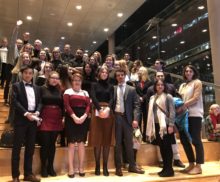View our story and other photos from the evening on Instagram!
Students from the Centre for European, Russian, and Eurasian Studies (CERES) had the opportunity to enjoy a night out at one of Toronto’s finest artistic institutions, the Canadian Opera Company (COC). On October 24 and 26, more than 50 CERES graduate and undergraduate students attended a performance of Antonín Dvořák’s opera, Rusalka.
Rusalka is based on Hans Christian Andersen’s fairy tale, The Little Mermaid. The title role, a lake-dwelling water sprite, sacrifices her voice with help from a witch in order to become human and pursue a prince with whom she has fallen in love. Dvořák’s opera, unlike the Disney adaptation, follows Andersen’s story more closely and is much darker and more mysterious than the American version – and foregoes the happy ending.
The opera received its premiere in 1901 at the National Theatre in Prague. The COC production performed the work in the original Czech.
Joseph Hawker, Research and Projects Coordinator at CERES and an opera lover himself, organized the outing. “This was an opportunity to incorporate the arts in our programming and remedy a bit of a blind spot,” he explained. “Although we are an interdisciplinary centre, the research interests of our faculty and students tend to be concentrated in the fields of political science and history.”
For many students, this was their first trip to the opera. Many dressed up and sipped wine during the two intermissions during the three-and-a-half-hour performance.
Rusalka is an incredibly expressive work. Its most famous aria takes place in the first act, when Rusalka sings of her love of the prince in the “Song to the Moon” (Měsíčku na nebi hlubokém). Dvořák was fascinated with opera and thought that it was “the most suitable” musical form for the Czech nation. Many of his works, including Rusalka, incorporate traditional Slavic folklore and music.
CERES graduate student Dashi Bouvier-Valenta’s, whose first language is Czech, enjoyed the performance. “I really appreciated the casting of the production because they had several lead roles cast with people who understood the lyrics. It really came through.”
Many students were impressed with the production, directed by Sir David McVicar, and especially admired the beautiful sets designed by John Macfarlane. The first and third acts take place in Rusalka’s watery home, full of blue-green shades in front of a forest background. The second act takes place in the prince’s palace, in a great Gothic hall lit in red.
Anna Herran was among a group of students who were given a backstage tour by COC Ballet Mistress Annemarie Cabri and organized by long-time CERES supporter Georgina Steinsky. She said she loved “having the chance to see the set, see how much detail goes into that, how much they work for that.” Students also had the opportunity to meet several members of the cast.
Herran had also seen Rusalka performed in Prague, but said the production was much more modern and minimalist. “Here they put a lot of effort into the sets. I think I like the one here better,” she said.
To some, opera may not have a obvious links to the subjects studied by CERES scholars, but Hawker believes that its connections shouldn’t be underestimated.
“Opera itself is interdisciplinary,” he says. “In addition to music and theatre, the full context of these works requires the study of history, literature, languages, and politics. It’s an ideal intersection at which to study Europe – much like CERES.”
by Catherine Lukits, MA candidate
